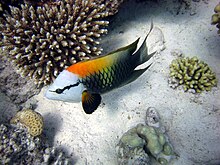
The wrasses are a family, Labridae, of marine fish, many of which are brightly colored. The family is large and diverse, with over 600 species in 81 genera, which are divided into 9 subgroups or tribes. They are typically small, most of them less than 20 cm (7.9 in) long, although the largest, the humphead wrasse, can measure up to 2.5 m (8.2 ft). They are efficient carnivores, feeding on a wide range of small invertebrates. Many smaller wrasses follow the feeding trails of larger fish, picking up invertebrates disturbed by their passing. Juveniles of some representatives of the genera Bodianus, Epibulus, Cirrhilabrus, Oxycheilinus, and Paracheilinus hide among the tentacles of the free-living mushroom corals and Heliofungia actiniformis.
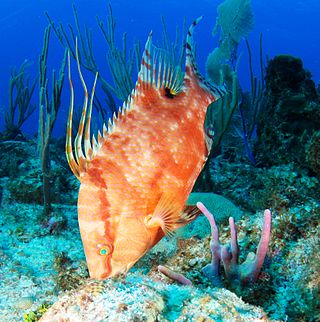
The hogfish, also known as boquinete, doncella de pluma or pez perro in Mexico is a species of wrasse native to the Western Atlantic Ocean, living in a range from Nova Scotia, Canada, to northern South America, including the Gulf of Mexico. This species occurs around reefs, especially preferring areas with plentiful gorgonians. It is a carnivore which feeds on molluscs, as well as crabs and sea urchins. This species is currently the only known member of its genus.
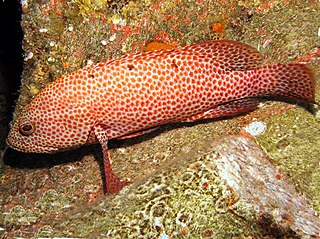
The graysby is a species of marine ray-finned fish, a grouper from the subfamily Epinephelinae which is in the family Serranidae which also includes the anthias and sea basses. It is found in the western Atlantic. It is associated with reefs and is a quarry species for commercial and recreational fisheries.
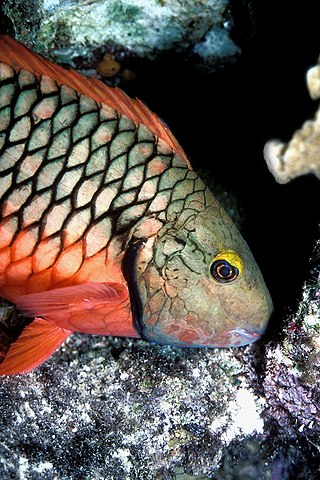
Sparisoma is a genus of parrotfishes native to warmer parts of the Atlantic. FishBase recognizes 15 species in this genus, including S. rocha described from Trindade Island in 2010 and S. choati described from the East Atlantic in 2012. They are the most important grazers of algae in the Caribbean Sea, especially since sea urchins, especially Diadema, the other prominent consumers of algae, have been reduced in many places by a recent epidemic.

The Christmas wrasse, also known as the ladder wrasse, green-barred wrasse or green-blocked wrasse, is a species of ray-finned fish, a wrasse from the family Labridae which is native to the Indian Ocean and the western Pacific Ocean. It inhabits shallow reefs at depths from the surface to 10 m (33 ft). It is of minor importance to local commercial fisheries and can be found in the aquarium trade.

Jansen's wrasse is a species of ray-finned fish, a wrasse from the family Labridae which is native to the Indian Ocean and Pacific Ocean. In the south-western Pacific Ocean it is replaced by sibling species black-barred wrasse. It can be found in the aquarium trade.

The bird wrasse, Gomphosus varius, is a species of the wrasse family.
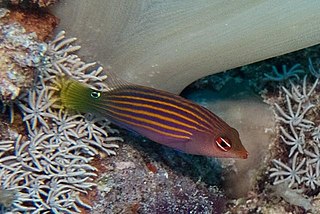
The six-line wrasse is a species of marine ray-finned fish from the family Labridae which has a wide Indo-Pacific distribution. This species is associated with coral reefs and can be found in the aquarium trade.

The coral hawkfish, the pixy hawkfish or sharp-headed hawkfish, is a species of marine ray-finned fish, a hawkfish belonging to the family Cirrhitidae. It is native to tropical reefs of the Indian Ocean and the Pacific Ocean. It occasionally is found in the aquarium trade.
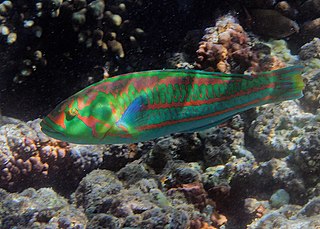
The surge wrasse, also known as the green-blocked wrasse, purple wrasse or red and green wrasse, is a species of wrasse native to the southeast Atlantic Ocean through the Indian and Pacific Oceans, where it inhabits reefs and rocky coastlines in areas of heavy wave action at depths from the surface to 10 m (33 ft). This species is of minor importance to local commercial fisheries, is popular as a game fish, and can be found in the aquarium trade.

The tubelip wrasse is a species of wrasse native to the Indian Ocean and the western Pacific Ocean. This species occurs in lagoons and on coral reefs at depths from 0 to 20 m. This species grows to 17.5 cm (6.9 in) in total length. It is of minor importance to local commercial fisheries and can be found in the aquarium trade. This species is the only known member of its genus.
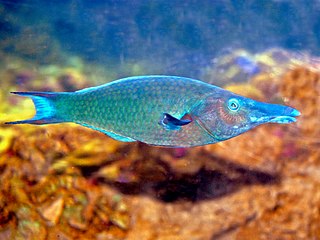
Gomphosus caeruleus, the green birdmouth wrasse, is a species of wrasse belonging to the family Labridae. It can be found in the aquarium trade.
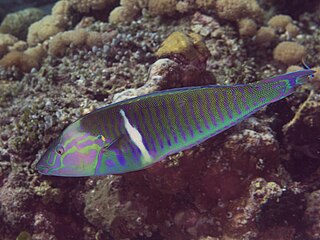
Hologymnosus doliatus, commonly called Pastel ringwrasse , is a marine ray-finned fish belonging to the family Labridae, the wrasses, which is found in the Indo-Pacific area.

Pristipomoides multidens, the goldbanded jobfish or goldbanded snapper, is a species of ray-finned fish, a snapper belonging to the family Lutjanidae. It is found in the Indian and Pacific Oceans.

Latent sling-jaw wrasse is a species of ray-finned fish from the wrasse Family Labridae which is associated with reefs in the south-western Pacific Ocean.
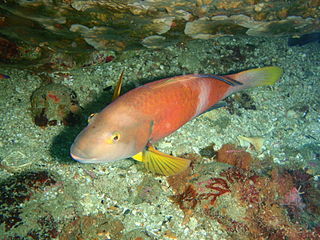
The blue-throated wrasse, also known as the bluehead, bluehead parrotfish, bluenose, bluenose parrotfish, bluethroat parrotfish, blue-throat wrasse, kelpie, lilac banded parrotfish, rocky bream, rocky cod, rotfish or winter bream, is a species of marine ray-finned fish from the family Labridae, the wrasses. It is found in the Indian and Pacific Ocean off the south-eastern coasts of Australia.
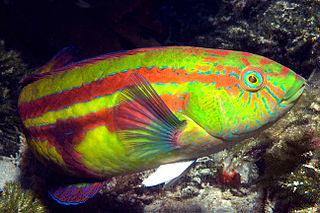
Pictilabrus laticlavius, the patrician wrasse, the senator wrasse, the green parrotfish or the purplebanded wrasse is a species of marine ray-finned fish from the family Labridae, the wrasses. It is found in the eastern Indian Ocean and the south western Pacific Oceans off he temperate coasts of southern Australia.

Pseudocoris heteroptera, the torpedo wrasse or zebra wrasse, is a species of marine ray-finned fish, a wrasse from the family Labridae. It is found in the western Pacific Ocean where it is associated with reefs.
Pseudojuloides cerasinus, the smalltail wrasse or the pencil wrasse, is a species of marine ray-finned fish, a wrasse from the family Labridae. It is found in the tropical Pacific Ocean and was previously considered to have a much wider distribution but the recognition of new species has reduced this wide range.

Cirrhilabrus finifenmaa, also known by its common name rose-veiled fairy wrasse, is a rainbow-colored wrasse that is native to the reefs of the Maldives.
